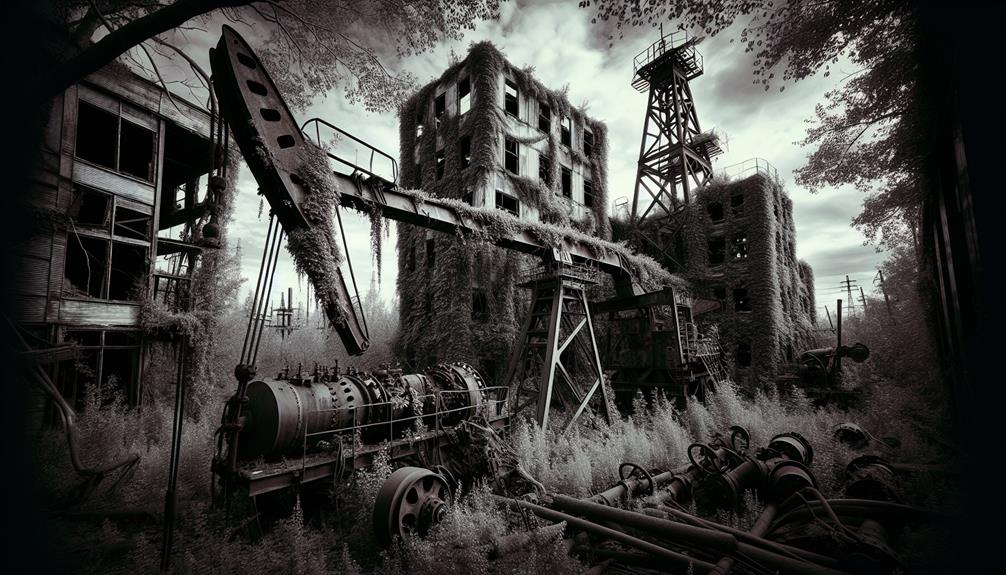You may be curious why forgotten oil industry ghost towns have vanished. The disappearance is a result of economic downturns, resource depletion, neglect, and corporate disengagement. As oil wells dried up, businesses suffered, and populations dwindled. Neglected infrastructure worsened degradation, and economic challenges converged to push these towns into abandonment. The shifting economic landscape reshaped these once vibrant communities, displacing residents and leading to job losses. Despite challenges in preservation, these ghost towns hold historical artifacts and architectural ruins offering insights into their past. Their lost heritage awaits rediscovery, revealing tales of resilience and innovation.
Key Points
- Depletion of oil resources led to economic downturns and lack of incentives for sustenance.
- Neglected infrastructure and abandoned structures exacerbated degradation and contributed to abandonment.
- Corporate disengagement resulted in dwindling resources and lack of support for town sustainability.
- Economic shifts reshaped landscapes, displacing communities and causing job losses.
- Limited funding hinders preservation efforts, while environmental factors and decay pose challenges.
Rise and Fall of Oil Boomtowns
During the oil boom era, vibrant boomtowns emerged almost overnight, only to fade into obscurity just as quickly when the oil wells ran dry. The rapid urban development that characterized these boomtowns brought both prosperity and chaos. As oil companies rushed in, infrastructure and housing were hastily constructed to accommodate the influx of workers and their families. Streets filled with bustling activity, businesses flourished, and a sense of opportunity hung in the air. However, this rapid growth often came at the expense of proper urban planning, leading to overcrowding, inadequate sanitation, and strained resources.
The environmental consequences of this unchecked development were severe. Oil extraction processes contaminated the surrounding land and water sources, leading to irreversible damage to the ecosystem. Spills and leaks further deteriorated the environment, poisoning wildlife and endangering public health. As the oil wells dried up and companies moved on, these once-thriving boomtowns were left deserted, bearing the scars of their unsustainable growth.
The rise and fall of these oil boomtowns serve as a cautionary tale of the importance of balanced urban development and environmental stewardship.
Factors Contributing to Abandonment
The abandonment of oil industry ghost towns can be attributed to a combination of economic downturns, depletion of natural resources, and the disinterest of corporations in maintaining infrastructure. As the oil industry faced fluctuations, towns reliant on it experienced economic instability, leading to businesses closing down and people moving away in search of better opportunities. This population decline resulted in a lack of community support and dwindling resources, exacerbating environmental degradation due to abandoned structures and neglected land.
Furthermore, the depletion of natural resources played a significant role in the abandonment of these towns. Once the oil wells dried up or became economically unviable, there was little incentive for residents to remain in these areas. The cost of extracting remaining resources often outweighed the profits, further discouraging investment in infrastructure maintenance. Ultimately, the convergence of economic challenges, resource exhaustion, and corporate disengagement culminated in the abandonment of these once-thriving oil industry ghost towns.
Impact of Economic Shifts
Economic shifts in the oil industry have played a pivotal role in reshaping the landscapes of once-thriving oil industry ghost towns. When economic downturns hit, these towns faced challenges as oil prices fluctuated, leading to closures of wells and companies relocating. The ripple effect was profound, causing community displacement as families and workers moved in search of new opportunities.
The impact of economic shifts on these ghost towns was multifaceted. As oil companies downsized or closed operations, the local economy suffered, leading to job losses and a decline in infrastructure maintenance. This domino effect created a sense of uncertainty and instability within these communities, ultimately contributing to their abandonment.
Moreover, community displacement became a harsh reality for many residents who were forced to leave behind their homes and memories. The once vibrant streets turned desolate as businesses shut down, schools emptied, and families scattered in pursuit of livelihoods elsewhere.
In essence, economic downturns in the oil industry not only affected the financial landscape but also tore at the social fabric of these ghost towns, leaving behind echoes of a once-thriving past.
Preservation Efforts and Challenges
Amidst the desolate remnants of once-thriving oil industry ghost towns, preservation efforts face formidable challenges in maintaining the historical integrity of these abandoned communities. To truly honor the past and preserve these unique pieces of history, it's essential to engage the community in the preservation process.
Here are some key challenges and strategies for preserving these forgotten ghost towns:
- Limited Funding: Securing financial resources for restoration projects can be a major hurdle.
- Structural Decay: Addressing the deterioration of buildings and infrastructure requires expertise and resources.
- Environmental Factors: Harsh weather conditions and natural disasters can further damage already fragile structures.
- Lack of Awareness: Increasing public knowledge about the historical significance of these towns is vital for garnering support.
- Sustainability: Developing sustainable preservation plans to ensure the long-term upkeep of these sites.
Rediscovering Lost Heritage
Facing the challenges of preservation in oil industry ghost towns, an essential aspect lies in rediscovering the lost heritage embedded within these abandoned landscapes.
When exploring these forgotten sites, you may come across a treasure trove of historical artifacts that offer glimpses into the past. From old drilling equipment to personal belongings left behind by former residents, these artifacts serve as windows to bygone eras, enriching our understanding of the town's history.
Additionally, the architectural ruins scattered throughout these ghost towns provide valuable insights into the construction techniques and design aesthetics prevalent during the oil boom era. By examining the structural remnants of abandoned homes, businesses, and industrial facilities, you can piece together the town's architectural evolution and the impact of the oil industry on its built environment.
Rediscovering lost heritage in oil industry ghost towns not only preserves history but also fosters a connection to the past, allowing us to appreciate the resilience and innovation of those who once inhabited these now-desolate lands.
Frequently Asked Questions
What Were the Social Dynamics Like in Oil Industry Ghost Towns During Their Peak?
Imagine the hustle in oil industry ghost towns at their peak. Social dynamics were intense as economic impact fueled competition and collaboration. Residents navigated a transient, fast-paced lifestyle, shaping tight-knit communities amidst boom and bust cycles.
How Did the Oil Industry Ghost Towns Handle Environmental Challenges Such as Pollution and Resource Depletion?
You addressed environmental challenges in oil industry ghost towns by concentrating on rehabilitation and involving the community. Sustainable development and diversifying the economy were crucial. The towns endeavored to balance progress with preserving nature for future generations.
What Role Did Government Policies Play in the Abandonment of Oil Industry Ghost Towns?
Government regulation played a pivotal role in the abandonment of oil industry ghost towns. Economic impact was significant as policies influenced industry shifts. Regulations dictated operations, affecting towns economically, leading to their decline and eventual abandonment.
Are There Any Unique Architectural or Cultural Features That Were Specific to Oil Industry Ghost Towns?
Explore the remnants of oil industry ghost towns, uncovering unique architecture like abandoned wells and company-built housing. Discover the cultural significance of these towns, once thriving but now silent witnesses to a bygone era.
How Have Local Communities Outside of the Oil Industry Been Impacted by the Disappearance of These Ghost Towns?
Local communities outside the oil industry have felt the ripple effects of vanishing ghost towns. The economy suffers from lost revenue, while community relationships strain due to the sudden disappearance of once interconnected social ties.



